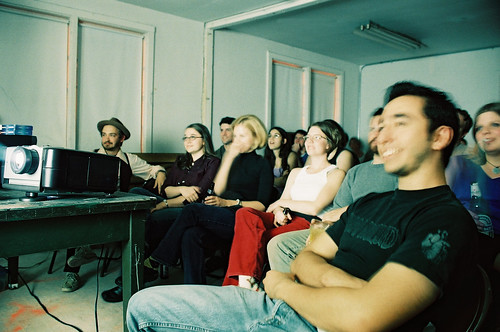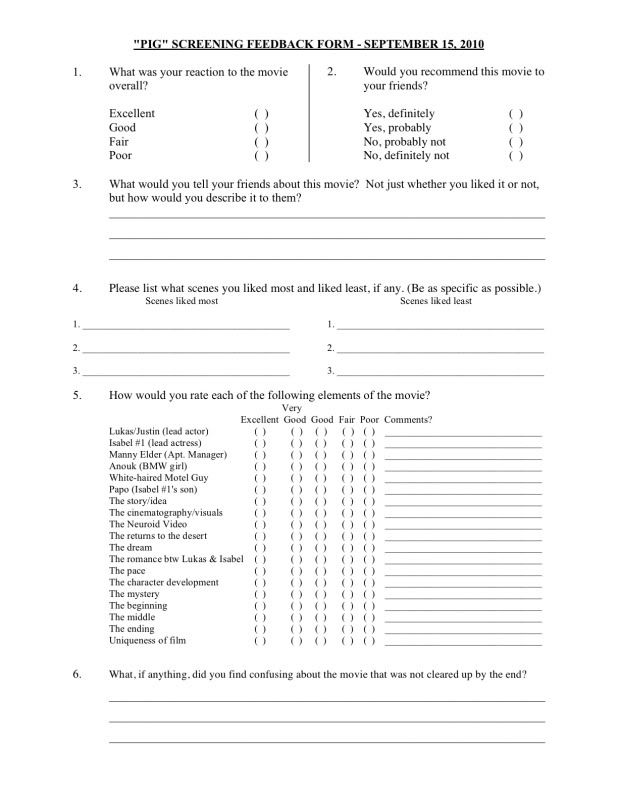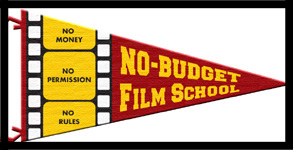 |
| Your test screening... |
Many
filmmakers are familiar with the Studios' penchant for test-screening their films, and if you're like a lot of independent
filmmakers, you probably imagine a process whereby challenged studio execs with MBA's rather than MFA's, and without
any knowledge of how to make a good film, use these screenings to pander to audiences silly enough to accept all those "come
to a free screening" invitations from folks trolling Hollywood Blvd. A true artist has a singular vision and is not
interested in making lowest common denominator entertainment for the masses of asses, right? For an independent filmmaker,
these screenings are for the birds. Right? Wrong.
I can't say with certainty how the studios use test screenings--for
good or for evil. I have my opinions and I've certainly heard horror stories, but I've never worked for a studio
and witnessed that process first-hand. I have, however, produced my own movies, ones that were meant to be artistically courageous,
that attempted to cut new paths and that were for all intents and purposes "specialized audience" films. They were
made with complete creative control and it was not incumbent on the filmmakers to bend to the will of financiers, and make
the films more accessible in order to appeal to a broader marketplace.
Still, I have found the audience test
screening to be an important, nay, crucial part of the post production process and this idea has been echoed by many other
indie filmmakers working on films that we all love for their "independence," not for their watered-down appeal.
The Blair Witch Project filmmakers made drastic changes based on feedback screenings that made the film more unique
and actually, much riskier. I attended a screening of
Paranormal Activity where filmmaker Oren Peli described how
his film went through some 50 test screenings in order to get things "right"--25 of them before Paramount became
involved and another 25 afterwards. Several of these latter screenings were used to test notes given to them by the studio--most
of those notes were bad for the film, something that was proven out in the screenings.
For independent filmmakers
there is a right way and a wrong way to handle these screenings and it is through my personal experience--especially the experience
of my current film
Pig--that I have come up with this guide to effectively test screen your film during post.
SCALE.
It's important to note that your screenings do not have to be done on the scale of a studio screening. I'm not talking
about renting a screening room and hiring a company to find a decent sampling of viewers. While you can certainly choose
to do that, that method is expensive and not necessary if your goals are more about improving the film rather than testing
a finished product's viability in the marketplace.
GOALS. The kind of screening I'm
talking about is used to test very specific things in your film. You may think your film is working one way, but after the
months or years conceiving the project, the months prepping it, the weeks shooting it, and the months or years editing it,
I can tell you, you've lost objectivity! How do people feel about your lead character; are they understanding what's
going on in the first act; do they need to completely understand what's going on in the first act; is the middle too slow,
too long; is the third act resolution happening too quickly; these are just a few examples of the things you might test in
a screening. This process is generally NOT about testing the film's popularity. You are more than likely making a film
that by design is not supposed to be "popular." Maybe your film is intended to piss everyone off. Is it doing
what you think it's doing? That's what you're trying to figure out. You should have some specific questions
to ask and specific goals you want to achieve for each screening. Though admittedly, these screenings can be very useful in
figuring out how broadly your film plays. It may not be important that your indie festival film plays broadly, but it's
vital to know. You may be making a lot of assumptions about your film's playability, that will affect your whole distribution
and marketing strategy, and all of those assumptions may be dead wrong!
 |
| ...will probably look like this. |
WHO
ATTENDS? Generally you're going to invite your friends, (these are the only people you're going to get anyway,
right?), and then ask them to invite one or two folks who don't know you or anything about the film. I think it's
a good idea to get as many people as your facility can hold--and as many strangers as you can muster--but generally, between
10 and 20 is a good number to shoot for. I like to have a diverse audience--a wide age range, evenly split male/female, multiple
races, and varying movie tastes. Yes, if your film is like
Old Joy and seemingly nothing happens, then you will
have several folks who probably will not like it, but again, you are not necessarily testing if they like your film. You
want to know, was it clear, after you cut the scene that explains the lead character's motivation, why he went back to
the house, or is it important that the audience knows why he went back to the house. To make sure you get your quorum, without
over-exceeding your capacity, it needs to be clear whether or not those you invite are attending. You need to stress to them
an RSVP is essential. It's not, "yeah, I'll try to be there, and I'll see if I can bring someone."
They need to tell you for sure if they are coming and if they are bringing anyone. And you need to get the name and email
address of everyone who attends, (have a sign-up sheet on a clipboard). These are potentially the first fans of your film,
and if they like the film or at least liked you and enjoyed the experience, they can be useful champions later in the process.
Despite everyone's best intentions, there will always be no-shows, so it's a good idea to over-book to get your number.
Something I've also found--your film will always play better for a bigger audience.
WHERE?
If you're working on a low budget (like I am) and you plan to hold several of these throughout the editing process (like
I do), you want to hold these screenings somewhere easy and cheap (read: FREE). I don't rent a theater; I find a house
or apartment that is conveniently located in town, with easy parking, and enough chairs and viewing space to hold the 10-20
people I mentioned above. This might be your place, (hopefully), or various homes of friends and family.
PRODUCTION
VALUE. You will be holding the screenings before the film is finished, and importantly, before a number of elements
have been added or refined in the cut. I'm referring to music, sound, color grading; or maybe you haven't shot everything
yet; or maybe you're missing some special effects. It's important to first give your audience the Caveat Speech,
where you explain where the film is technically. But you have to remember that these are not "sophisticated" viewers
who can easily look past glaring technical issues. And when I say that, I mean to say that really none of us are easily able
to ignore these issues, especially on a cumulative basis. The way around this is to get certain aspects as close to "refined"
as possible. If you plan to have music in a scene, you should drop in some temp music. If your audio backgrounds are so
different under the dialogue of two different characters that you notice every time you cut between them--you "hear"
the cuts--then you need to spend a day or two evening out that sound. You need to do a preliminary mix and you need to adjust
color levels enough so that they don't take the audience out of the film. With
Pig we used title cards in place
of scenes we hadn't shot yet at first, but ultimately to get an idea of how that stuff was working, we had to shoot some
temp footage and cut that in. (Turns out that once we had a chance to replace that footage in our pick-up shoot, we preferred
the temp footage and now that's what's in the film.) Since you have probably shot in HD, I would screen an HD version
of the film, rather than burn it to an SD DVD. We have been creating Quicktimes (that are in our camera original XDCAM format
and are as high a quality as we can get) and running them out of a laptop using Final Cut Pro (rather than Quicktime Pro),
into an HDTV through the HDMI input, (we have a DVI to HDMI cable). This has been really easy to do and the quality has been
great. Make sure you have a good set of speakers so that your audio sounds good too, especially since your audio work isn't
done yet and your levels aren't going to be perfect. Try to use the biggest screen you can find. Turn down the lights.
 |
| Sample feedback form from "Pig" |
FORMS.
Just like the big boys, you'll to want to have forms for people to fill out once the screening is over. I everyone ahead
of time that they will be watching the film and then immediately afterwards, before they break, they will fill out the forms,
before discussing what they thought with anyone. The forms are anonymous and you need to make it clear that their candid
opinion is what you seek. Sugar-coating something they didn't like does no one any good. I print them out two-sided
on card stock and provide pencils. A sample of a form I've used on
Pig is
here.
DISCUSSION. After everyone has filled out the form, you want to open it up for discussion.
I don't like to lead people too much at first--I'm more interested in seeing what kinds of issues come up naturally
in the discussion. Certainly, though, I will have particular questions or issues that I need clarity on and ultimately I
will ask a series of pre-determined questions. You should be asking questions here, not giving answers. If someone asks
about a story point or a character's motivation, it's not your job to clarify, it's your job to understand if
the film is doing what it needs to do with regard to these issues. Ask that person what
they thought was the character's
motivation. Are they giving you the answer you want? Was it distracting for that person not knowing? I've found that
certain people can take over these sessions, while others who may have opposite opinions will sometimes remain silent, not
interested in rocking the boat. You need to be aware of this dynamic. Don't let the loud ones determine which way your
film goes. Ask if someone has a different opinion. Check in with the silent ones for their thoughts. This is why it is so
important to do forms before a discussion, when everyone is on equal footing and no one's opinion is influenced by anyone
else's. You'll often find that what's been said and what's been written conflict. So why do a discussion
in the first place? The discussion gives breadth and richness to what's been written and more importantly, opens up the
forum to issues you may not have realized were issues. The form is necessarily reductive; the discussion is open-ended.
REFRESHMENTS. You want this to be a positive experience for everyone and it's going to be
a long evening, what with the gathering before the film starts, the running time of the film, and the discussion afterwards.
Make sure to serve some kind of food and drinks--it could be as simple as cheese and crackers or pizza, or something more
elaborate, but the goal is to provide something decent without spending too much money. One question that always comes up
is whether or not to serve alcohol. I like the idea that these screenings are fun--a kind of party--but I don't like
alcohol served before the screening. Wine makes people sleepy and when your film ultimately screens at a film festival or
in a theater, it is unlikely that your audience will have been drinking. You can always serve alcohol afterwards, and that
might even spur a more candid discussion.
RESULTS. This might sound counter-intuitive, but
you can't put too much emphasis on your results, at least not in a statistical way. It's easy to quantify the results
you get from these screenings, but as any statistician will tell you, your non-random, woefully small sample is not going
to give you quantitatively accurate results. This is not an election poll (which are often wrong anyway), but rather a subjective
interpretation of what a particular audience thinks of your film. I'm telling you, interpreting the results can be very
difficult. The more you can put a numerical value to certain questions, the greater the temptation to quantify. So, for
instance, if your first question is "What was your reaction to the movie overall?" and your four choices are:
Excellent, Good, Fair, Poor; then it is easy to give each response a number, (Excellent - 4; Good - 3; etc.), and then quantify
what that audience thought of that version of the film by averaging out those numbers. You might compare that number with
the overall number you get from the next screening, where you made a big change. If you lean too hard on these kinds of numbers,
however, they may steer you wrong. There are all kinds of reasons why these numbers are not statistically sound. They may
have value, but there are many other variables that in a small sample size will have greater affect, and so, you need to try
to understand those variables as well as possible. And even though the forms are anonymous, I like to have an idea of whose
form is whose. Since it's not a perfect sample, if someone blasts the film or doesn't like a particular element,
it helps to know who they are. Maybe it's your friend who hates it every time the guy gets the girl, (another reason
to have the discussion--you can match forms to people). What I try to gain from both the cards and the discussion is the
gestalt of the audience response and their opinion on specific items. In fact, many times I find the most valuable part of
a screening isn't from the cards or the discussion, it's just what I feel while watching the film with that audience.
You can really
feel the room in most cases, and that can tell you everything you need to know. This is for sure--the
experience of watching the film with an audience versus watching it by yourself is night and day.
HOW
MANY? Do as many of these as you need. Make them easy enough to organize so you're not sacrificing your film
because it's become a pain in the ass to put one on. Yes, it is work to arrange, but we've gotten ours down to a
science, so that I can have one organized in just a few days. As you make changes, think of these screenings as a science
experiment. In some cases you may need to test one single key change. You'll want to keep all your other variables the
same to accurately test that change, so don't make three other lesser changes that may foul up your control. If you have
a film like ours--a mystery where the third act reveal makes you reevaluate everything you've just seen--you'll need
to find fresh blood every time you screen. Have a pool of people you can call on readily available.
CONCLUSION.
Don't get down when these screenings don't go the way you always hoped. I can tell you that the first screening
you hold will not bowl them over. Have faith that the changes you make based on the feedback you get will improve the film.
I can assure you, it will. And all the little things you do once you lock will also have an overall effect on the audience,
things like post sound, original music, and color correction. If you can entertain an audience without all these things,
then you're in pretty good shape. Also, don't let your ego get in the way--it's not a reflection on you or your
filmmaking ability to hold these screenings. You are going to be getting feedback on your film all along the way, and much
of it may surprise you. Better to be surprised while you can still make changes and improve the film, not after 10 film festival
rejections indicate there are problems.

